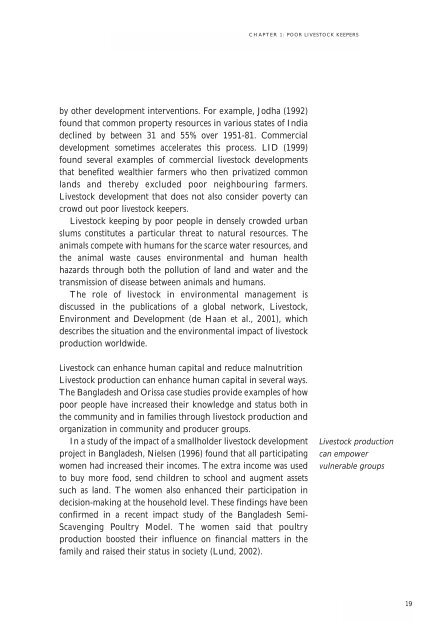Livestock Services and the Poor: A global initiative - IFAD
Livestock Services and the Poor: A global initiative - IFAD
Livestock Services and the Poor: A global initiative - IFAD
You also want an ePaper? Increase the reach of your titles
YUMPU automatically turns print PDFs into web optimized ePapers that Google loves.
CHAPTER 1: POOR LIVESTOCK KEEPERS<br />
by o<strong>the</strong>r development interventions. For example, Jodha (1992)<br />
found that common property resources in various states of India<br />
declined by between 31 <strong>and</strong> 55% over 1951-81. Commercial<br />
development sometimes accelerates this process. LID (1999)<br />
found several examples of commercial livestock developments<br />
that benefited wealthier farmers who <strong>the</strong>n privatized common<br />
l<strong>and</strong>s <strong>and</strong> <strong>the</strong>reby excluded poor neighbouring farmers.<br />
<strong>Livestock</strong> development that does not also consider poverty can<br />
crowd out poor livestock keepers.<br />
<strong>Livestock</strong> keeping by poor people in densely crowded urban<br />
slums constitutes a particular threat to natural resources. The<br />
animals compete with humans for <strong>the</strong> scarce water resources, <strong>and</strong><br />
<strong>the</strong> animal waste causes environmental <strong>and</strong> human health<br />
hazards through both <strong>the</strong> pollution of l<strong>and</strong> <strong>and</strong> water <strong>and</strong> <strong>the</strong><br />
transmission of disease between animals <strong>and</strong> humans.<br />
The role of livestock in environmental management is<br />
discussed in <strong>the</strong> publications of a <strong>global</strong> network, <strong>Livestock</strong>,<br />
Environment <strong>and</strong> Development (de Haan et al., 2001), which<br />
describes <strong>the</strong> situation <strong>and</strong> <strong>the</strong> environmental impact of livestock<br />
production worldwide.<br />
<strong>Livestock</strong> can enhance human capital <strong>and</strong> reduce malnutrition<br />
<strong>Livestock</strong> production can enhance human capital in several ways.<br />
The Bangladesh <strong>and</strong> Orissa case studies provide examples of how<br />
poor people have increased <strong>the</strong>ir knowledge <strong>and</strong> status both in<br />
<strong>the</strong> community <strong>and</strong> in families through livestock production <strong>and</strong><br />
organization in community <strong>and</strong> producer groups.<br />
In a study of <strong>the</strong> impact of a smallholder livestock development<br />
project in Bangladesh, Nielsen (1996) found that all participating<br />
women had increased <strong>the</strong>ir incomes. The extra income was used<br />
to buy more food, send children to school <strong>and</strong> augment assets<br />
such as l<strong>and</strong>. The women also enhanced <strong>the</strong>ir participation in<br />
decision-making at <strong>the</strong> household level. These findings have been<br />
confirmed in a recent impact study of <strong>the</strong> Bangladesh Semi-<br />
Scavenging Poultry Model. The women said that poultry<br />
production boosted <strong>the</strong>ir influence on financial matters in <strong>the</strong><br />
family <strong>and</strong> raised <strong>the</strong>ir status in society (Lund, 2002).<br />
<strong>Livestock</strong> production<br />
can empower<br />
vulnerable groups<br />
19

















